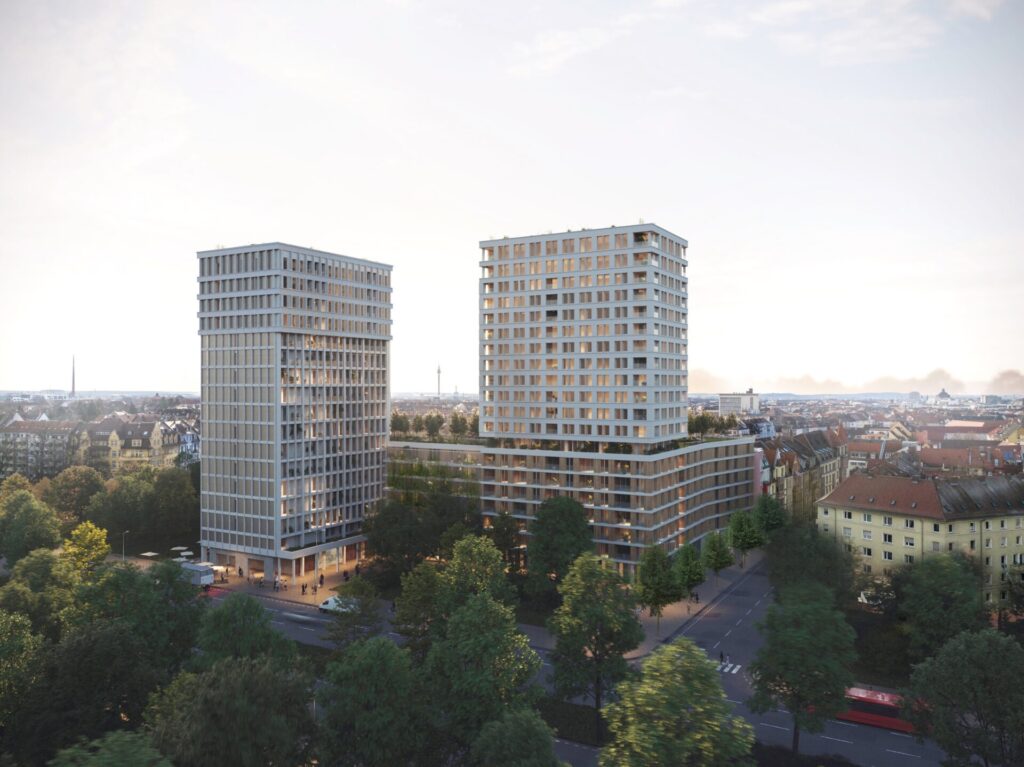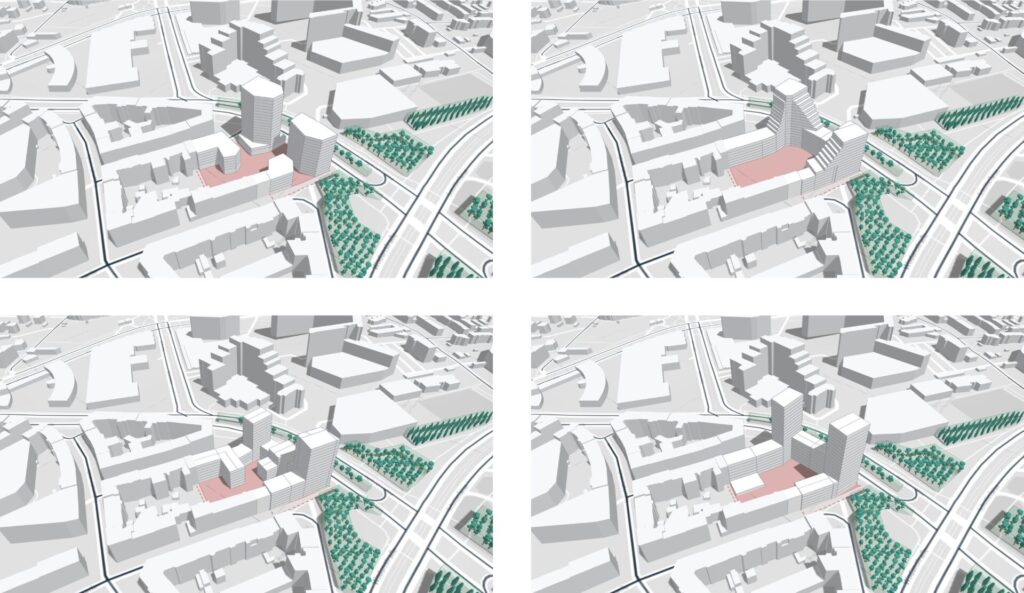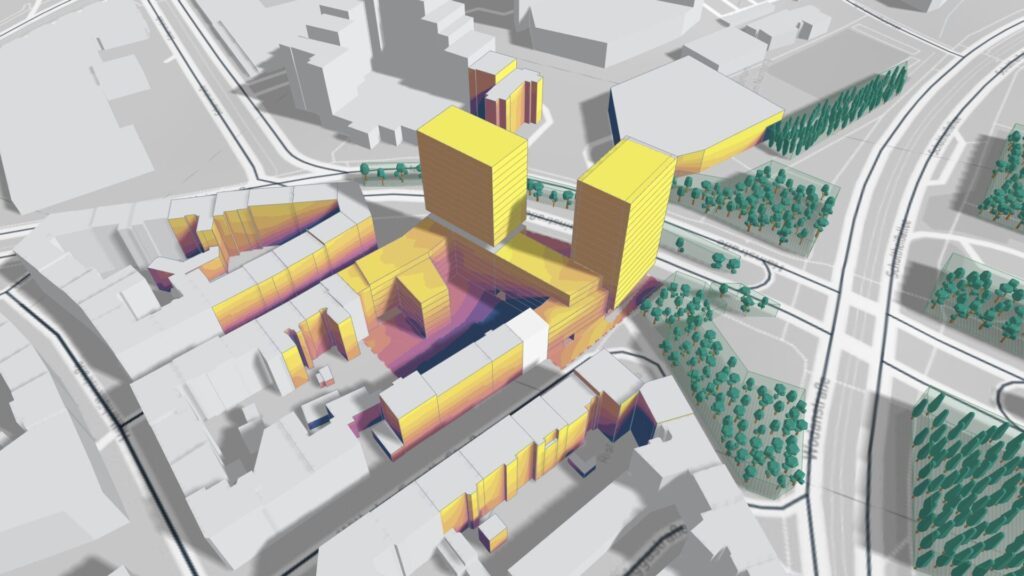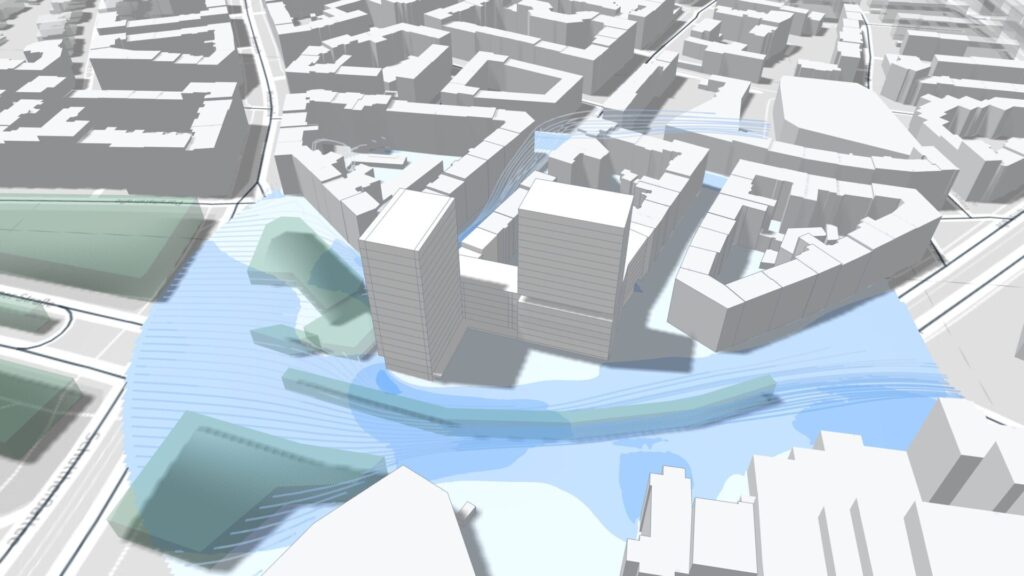
Image credit: Gräßel ARCHITEKTEN/ Grauwald Studios and BPD
Executive summary:
- When preparing a design competition for a new housing project in Nuremberg, Germany, leading property developer BPD (Bouwfonds Immobilienentwicklung) used Autodesk Forma to help the team assess the site more precisely and make informed decisions when identifying potential opportunities and risks.
- Using Forma’s analyses, the team was able to build a solid case to obtain approval from the municipality to increase the density by 22% from the original design, and prove that there would be no new negative impacts on wind flow and sun conditions on neighboring buildings.
- With Forma’s easy-to-understand visuals at hand, this significantly improved the communication and collaboration process with the municipality, securing stakeholder buy-in for their plans at an early phase and reducing discussion time to enable the team to focus on more important parts of the project.
As cities feel the pressure to accommodate ever-growing urban populations, municipalities are looking to densify existing neighborhoods to build new housing. By repurposing existing structures and optimizing available land for urban development, urban densification aims to limit a city’s footprint, both physically and environmentally and enables infrastructure and amenities to be used more efficiently. In the process, it can potentially boost neighborhoods and strengthen communities. Densification demands that municipalities, architects, developers take a considered approach to ensure a high quality of living for residents, minimize environmental impact and improve climate resilience. In essence it can be a trigger for sustainable urban development but only when it’s considered hand-in-hand with livability.
Navigating the complexity of urban sites
Compared to greenfield sites, urban projects are often more complex to develop due to the existing site conditions from public space and microclimate to infrastructure, and impact of new structures on the urban fabric, especially when it concerns a higher level of density. Strict regulations govern height restrictions, setbacks, access to daylight, quality of outdoor space and more. Existing buildings may need to be retained. With multiple stakeholders involved, it can be challenging to manage everyone’s differing needs. In this sense architects and developers need to work with extreme precision to ensure a project responds to all these specific conditions and requirements.
When planning sites, this early phase poses a challenge due to a shortage of time and resources, and high risk given there is not always good information nor effective tools available for assessing sites quickly and precisely. As early adopters of data-driven tools for development, BPD, the largest developer in the Netherlands and Germany, was able to leverage Autodesk Forma’s advanced analyses at the early phase to ensure successful outcomes for a residential project in Nuremberg, Germany. This helped them make informed decisions when identifying the opportunities and risks of developing a complex urban site and ensure stakeholder buy-in at an early phase for their plan to add a new, sustainable landmark to the neighborhood.
Liveability is priority
Like in many German cities, Nuremberg, the second largest city in the state of Bavaria, is experiencing a housing shortage. Its many educational and cultural institutions, industries, and historical charm make Nuremberg an attractive city to live in. A vibrant neighborhood, which provides the basis of a high-quality residential environment, is a must for BPD when searching for suitable sites for housing. Here in Nuremberg, one of these neighborhoods is situated in the south-east of the city–it’s a location with great potential explains Fabian Kuusik, project developer at BPD. “The site is well connected to a major ring road and public transport by trams, busses, and good bike lanes so you can easily reach the city center. Shops, schools and parks are within walking distance and the Meistersingerhalle Nuremberg, the city’s renowned main concert hall, is located opposite–all in all it’s a great place to live.”
Enhancing the neighborhood
When BPD purchased the 5,290 m2 site, there was already planning approval in place for a residential development. The site previously housed offices and has an existing 13-storey tower which BPD wanted to repurpose into housing. Seeing the potential to improve the development in terms of density, sustainability and community, the team decided to organize an invited competition. The plan envisioned a new sustainable landmark in the city that would add a social boost to the neighborhood. A program of mixed housing (social and owner occupied, studios to family apartments) would bring together different types of residents while retail, a café and a daycare center occupy the ground floor. The goal to achieve a high level of sustainability demanded a solid strategy encompassing all aspects of the design from materials, energy and mobility to water treatment and climate adaptation.
New technology helps minimize risk and maximize opportunities
Organizing such a competition meant BPD needed to collaborate closely with the municipality to obtain approval. Firstly, the team needed to scope the site in-depth to reassess the feasibility. In both cases, using Autodesk Forma helped the team build their case with successful outcomes in mind. “When exploring site feasibility, you can do quick studies in Forma which allow you to easily see the possibilities and risks in a development,” explains Kuusik.

Two of the proposed changes to the original plan were to place a second residential tower and add more storeys on the existing tower to create more housing. Given that there are other high-rises in the surroundings, a second tower would not look out of context. Kuusik: “When there are dense projects, the municipality will be concerned about the quality of life for people living in the neighborhood. When you can show that a certain density is viable, the municipality is open to discussing it. Using Forma we were able to get an idea of how the density could look like and show the municipality that our proposal wouldn’t have a negative impact on wind flow and sun conditions on the neighboring buildings.”

Advanced analyses show the impact in an instant
The team first tested different options with various types of volumes to explore the density, form–especially how it connects with the existing tower and neighboring buildings–and impacts. “With all the proposals, we used Forma’s analyses to first check the existing conditions and then the new conditions with the different options,” explains Kuusik. Using the sun hours analysis, they were able to check if any issues would arise with overshadowing. The noise analysis helped the team see any problematic facades to already consider mitigation strategies where needed, for example through noise barriers or window types and façade materials. Importantly, the wind analysis enabled them to verify that there weren’t additional wind tunnels created nor blockage of wind flow into the city. “Cities tend to overheat especially during the summers, and when you have structures that block the wind, this worsens the overheating even more,” says Kuusik. “So we need to check how high we can build within the city without blocking air flow into the city. As there is already an existing tower, our new development wouldn’t further block the cooling winds from the south.”

Improved collaboration; improved outcomes
As a result, the team was able to increase the density of the project by 22% from the original plan, which allows more residents to be able to live here. At the same time this increase enabled more larger apartments to be built which improves the mix of housing on offer. Having Forma’s analyses at hand as clear evidence of their investigation was critical to having the competition approved by the municipality with this increased density. After the competition, BPD also requested that the winning scheme from Gräßel ARCHITEKTEN was analyzed in Forma to ensure there would be no additional issues. “This makes the dialogue with the municipality easier because you can show that you’ve studied the conditions thoroughly and you’ve taken the issues seriously. When you give them proposals that work, they see you’re keeping your word– this creates a lot of trust,” says Kuusik.
This new data-driven way of working has paid off for the BPD team in Nuremberg. “We didn’t use analysis software ourselves before previously. Using Forma helped a lot because obviously you have visual proof–and this is important when it comes to complex projects,” continues Kuusik. “Plus, it’s very easy for everyone to understand meaning we could not only show the results to the municipality but also to the neighbors during community meetings. All in all, it helped us spend a lot less time on the site assessment and discussions, and concentrate on the most important part of the project which is to create sustainable, high-quality homes for people to live happy, healthy, and fulfilling lives,” concludes Kuusik.